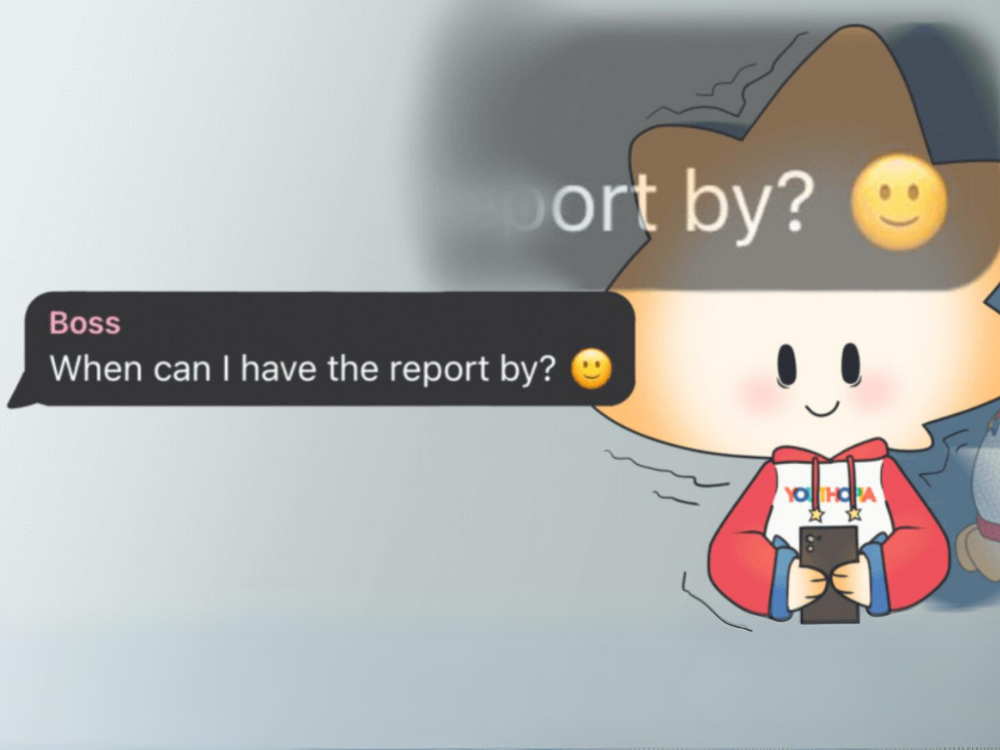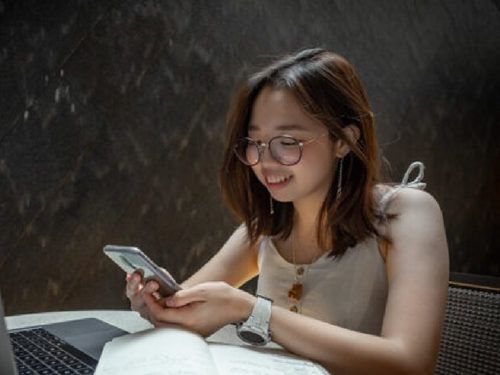Does my boss want to fire me, or was that thumbs up for real?: Working youths and online communication anxiety
1 November 2023
Some youths cited generational differences, past slip-ups, and gender discrimination as reasons behind their anxieties.
Written by: Keolah Cheah

Have you ever been sent a smiley face by a team leader or superior?
In this blip of time on our great green Earth, a smiley face, once a symbol of joy and merriment, has morphed into an ugly way to convey passive aggression.
Then, thinking between the two camps – those who use it genuinely and those who don’t – you have to scramble your entire worldview together and assess if you are about to be scruffed and tossed out on the office doorstep.
This is just one of the events that can scare youths in a workplace context, where an increasing number of workplaces are using online means of communication to relay tasks and feedback.
Of the six Gen Zs (those born from 1996 to 2010) who shared their views on workplace anxiety with Youthopia, the majority of them feel decently prepared for the world of work.
When it comes to workplace communication in particular, this aspect makes them feel nervous, or has tripped them up in prior work engagements or internships.
The Communication Conundrum: Why is it difficult?
For youths in the workplace, communication difficulties can be caused by the generational gap between supervisors and fresh hires.
According to Dr Elmie Nekmat, associate professor in Communications and New Media at the National University of Singapore (NUS), “[youths] do speak a different language.”
Dr Nekmat, who signs off his emails with “Stay slay!” and speaks of his students with real fondness, further shared that youths tend to communicate with unique slang regularly with their peers.
While they are able to code-switch to more professional language, he said there is often still a “language difference or barrier” between youths and their older colleagues. In his own experience attempting to connect with youths online, he finds a lack of engagement.
“The students shared with me the way I speak and the way I write is not the way they tend to… respond or communicate,” he said.
Youths may recognise this gap in their own interactions with parents or supervisors.
For some, it may be anxiety-inducing to receive a cryptic message from supervisors, especially with their use of emojis or slang. This is down to how each emoji or bit of lingo can be interpreted differently across generations.

My mother often uses the ‘hot’ emoji to mean ‘terrible!’ or ‘warm!’. It has… different connotations among youths. She will find out when she reads this. PHOTO CREDIT: YOUTHOPIA/KEOLA CHEAH
Other youths have noted that differences in punctuation have also caused anxiety during workplace communication.
Lim Hong Ying, 19, who interned under a telecommunication company’s cybersecurity wing, noted some communication blips with his colleagues, who were mostly older than him.
When one superior frequently ended sentences with ellipses (…), he worried that they might be disappointed in him, but found out that the older colleague was under the impression that the ellipses had given his sentences a more casual feel.
Additionally, he laughed over the fact that his superiors often used random emojis with no real regard as to what each symbol meant.

Even with Internet usage widening across generations, use of tools like acronyms can also be confusing when one party does not understand. PHOTO CREDIT: DISCORD/DONQUIXOTEFAN69
Throughout these various tools for communication, it can be interesting to note the differing nuances of their use between generational groups and niche communities.
Millennials may have popularised the use of acronyms like Talk To You Later (TTYL) and On My Way! (OMW; a plague on Autocorrect haters), but the specific acronyms used have changed with time.
For instance, while a millennial supervisor might use “Kk” instead of “Okay”, a Gen Z might use “kayyy” or “okie”.
Across niche communities, too, usage of acronyms might be indecipherable to others. Frequent gamers might understand Good Game, Well Played (GGWP), which is used in a literal sense after a successful fight or round of gameplay. It can also be used sarcastically; for example, if someone anticipates a scolding from their boss, they might drily say “GG” or “GGWP” to mean something along the lines of “It’s over.”
However, anyone outside of the gaming sphere receiving that message might feel totally lost, even if they share the same age group as the sender. As such, generalising language use across generations may not be entirely accurate for every piece of slang or lingo.
For one youth, Natalie Jean Loh, 19, wording and phrasing plays a big part in her workplace. Natalie, currently an intern at a food advertising agency, shared multiple learning experiences in terms of communication.
During a break on a work-from-home (WFH) day, she had to clean up a spill and sent a text along the lines of “Sorry! I need 15 more minutes, and I’ll be back.”
While she initially saw no issue with her wording, she found out during a chat with her supervisors that it could have been perceived as – in her words – “Hey! I’m gonna do this. Seeya!”.
The text failed to account for her colleagues, who may have wondered why their lunch break was only 45 minutes, while she, who had not provided a reason, got an hour’s break.
From this, she learnt that the expected wording would be along the lines of “This happened, I spilt something, I need a bit more time to clean up. I’m so sorry, but I will continue my work and finish it up.”
Despite the incident, she recognised the correction as something she stands to learn and grow from, rather than a personal attack.
“When I’m working with people who are older than me, it’s very important to give them that respect that they’re due,” she shared, a principle that extends beyond her supervisors to the clients she works with.
For some fresh grads and interns, the work environment also plays a big part in how confident they feel about communicating.
One youth who wanted to be known by only her surname Yeo, called her internship placement a “real fish out of water experience”, recalling a marked maturity difference between interns and superiors.
During her internship, the 19-year-old also observed that many of her peers were older than her. Of these peers, the majority happened to be male; she had just one female colleague.
“That was hard for me,” she said. “That was so hard.”
For Yeo, who had grown up around women until her graduation from an all-girls’ secondary school, having superiors who were mainly men proved anxiety-inducing. Besides the general anxiety of wanting to perform in the workplace, she also struggled with the fear of discrimination, which caused her to have “another level of vigilance… when going into work.”
While her workplace turned out to be safe in the end, she shared that looking out for potential harm was a large reason behind her anxiety in communicating. This was another layer of fear she had to grapple with when looking out for disappointment or hostility in superiors.

Workplace harassment was one of the top worries among youths polled during the Conversation on Women’s Development. PHOTO CREDIT: YOUTHOPIA/TIANA QUEK
Across the various youths who shared their opinions with Youthopia for this article, there was one common denominator among the youths who were not confident about communication: anxiety.
Why are youths anxious in the workplace?
Before trying to combat the situation, it is important for youths to understand exactly why they may be feeling anxious.
Dr Nekmat, who is also a Resident Fellow at the Ridge View Residential College in NUS, feels that the concept of homophily can be applied to youths’ unease in the workplace. Essentially, the concept means that “birds of a feather flock together.”
According to Dr Nekmat, homophily affects not only youths, but all human beings. It results in the desire to be among people similar to you, or those you aspire to be like.
With regard to youths in the workplace, who might be away from a majority-youth space for the first time, this can result in “a dissonance between what [they] feel they value and… opposing values.”
These opposing opinions and worldviews can arise from meeting superiors who hold differing worldviews due to difference in age, experience and background.
This effect is also observed by youths like Natalie, who laughingly brings up her lecturer’s shock at hearing youths affectionately greeting each other with “Hey, b*tch!”
The nuances in social behaviour between each generation means that a superior may not see the term as a sign of closeness between peers, and might view the interns who use it among themselves differently.
Besides homophily, another concept that might enhance this anxiety is synchronicity.

Synchronicity can be defined as response time. PHOTO CREDIT: YOUTHOPIA
According to Dr Nekmat, “Time now indicates a value in terms of the communication. It indicates how much you value this relationship… [and] work.”
Some youths felt that face-to-face communication was less stressful than online communication. For some, the use of online platforms like Google Spaces and email allows them more time to absorb information relayed to them.
However, with the expectation to respond in a timely manner, some found that they would slip up or make mistakes out of their need to be quick.
Lastly, Dr Nekmat has also observed that youths today tend to balance more than just work or their studies.
Some youths have to manage coursework and internships alongside “’side hustles.”

Dr Nekmat has observed students taking upwards of two internships during their student years. He feels that competition is getting stiffer for youths, which results in higher expectations among them. PHOTO CREDIT: YOUTHOPIA/JULIAN TAY
Others must balance social media, which he calls “pervasive” because youths cannot remove themselves from technology. Many have apps that are used for work and life management aside from their more general use of social media.
There, youths must also balance social lives on TikTok, Instagram, Twitter (or X – another change to keep up with), and more. Some apps, he said, even require users to reply within two or three minutes.
The use of social media can also contribute to youth anxiety due to the rise of communities like ‘Studygram.’ Educational and study-focused communities like it are generally made up of users who post bullet journal planning spreads, tips on how to succeed academically, and, of course, their own academic achievements.
While joining these communities for motivation can be beneficial, Dr Nekmat cautions youths against social comparison, which can often arise after frequent interaction with such posts.
When combined, all of these factors can contribute to and exacerbate the effects of workplace communication’s difficulty to youths.
What can be done to ease the difficulty of communication?
Of all the youths who shared their views with Youthopia, the majority of them stressed that despite the challenges, they were willing to remain open-minded. To many, obstacles and bumps, while anxiety-inducing, were learning experiences.
“Social interactions are always going to be complex and ever-evolving, so try to adapt as much as you can,” shared Maple Tan, 19, an ex-motion graphics intern.
Maple went on to say that “Humans are humans, we have a lot of unspoken rules that can be annoying.” Adding on, she mentioned that to overcome these rules, it is important for youths to negotiate and ask for boundaries in communication.

Discussing communication in a straightforward and open-minded manner with supervisors can be key in allowing youths to be comfortable in the workplace. PHOTO CREDIT: UNSPLASH/REDD F
Having that tough discussion can allow superiors to see the effort that youths are taking in trying to grow as a person. In this, it could also help to soothe youths’ worries in not feeling like their efforts are seen by their supervisors as opposed to their peers’.
Natalie, who herself struggles with anxiety, suggests that youths who find themselves battling it in the workplace can also ‘dissect’ the situation. “A lot of it is internal. Every individual would have their own ways of recognising… the anxiety.”
To lessen this anxiety in the first place, Dr Nekmat has his own suggestions.
“[Don’t] set incredible… expectations. Do not compare yourself to others,” he shared. “Set clear targets and goals for yourself… that you want to achieve out of this [work].”
A piece of advice that he gives even to his daughters is that while youths can try to do their best, there is a lot in the environment of work that is out of their control.
He cautions against self-comparison in a competitive, ‘rat race’ world. “Sometimes, doing enough is good enough.”
He emphasises the idea that communication is a two-way street, and not one that either side should feel they have the burden of carrying.
It is important for youths to make an effort to dispel their anxieties and step out of their comfort zones. Simultaneously, older colleagues can try to understand that “the youths are living in their own conditions”, where communication standards differ.
To facilitate this, both parties should enter the conversation without pre-conceived notions about the other, and can try to use language that is common between them.
“These conversations have to be more tempered [between the generations],” he said. “The older generations, or the more senior, need to be more genuinely accepting of the youths’ way of living, or their outlook in life.”
Other helplines you may find useful:
National Care Healthline - 1800-200-6868
TOUCHline - 1800-377-2252
Mindline SG - https://mindline.sg/
Limitless - www.limitless.sg/talk
Community Health Assessment Team (CHAT) - 6493-6500/6501
Singapore Association for Mental Health: 1800-283-7019
Samaritans of Singapore (24-hour hotline): 1800-221-4444
